As Benedict XVI, Joseph Ratzinger was head of the Catholic Church from 2005 to 2013. Using archival footage and conversations with contemporary witnesses, this film provides insight into the rise and fall of the German pope.
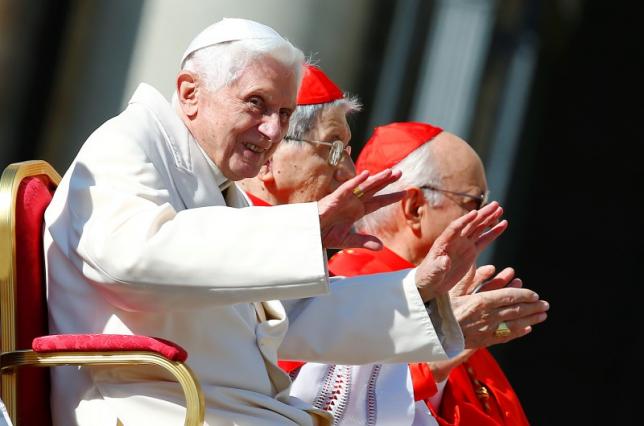

Alliance, Support & Activism

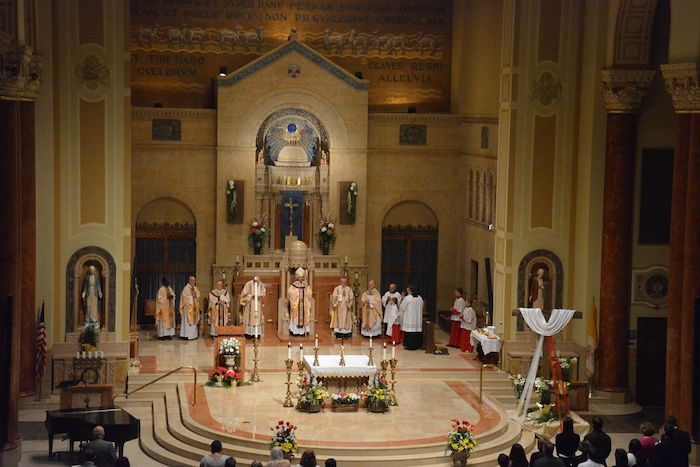
By James Finn
Fr. Andy Herman is a Roman Catholic priest who corresponds with me about LGBTQ issues. I have sometimes observed that Catholic priests are reluctant to publicly criticise Church teachings and practices.
Andy is a remarkable, refreshing exception. He offered to be interviewed. I asked him to write up a first-person story. This is it, after I edited and polished it. I wanted to keep him out of trouble with the Church, but he shows no evidence of wishing the same, which you’ll see in this impassioned, earthy plea for love and justice.
If this story inspires you, ask him for more, especially accounts of his youth rescue work in Los Angeles, which is hair-raising love in action.
(“Hi Andy!” )
I’m bisexual!
(“Welcome, Andy!” [Applause.])
And I have been “intrinsically disordered” for… 74 years!
([Applause picks up, whoops & shouts of encouragement and congratulations.])
I know that’s tweaked a bit, because to be honest I’m not personally familiar with 12-step meetings. But the real problem is, it’s ass backwards.
I retired myself from public ministry with the institutional Catholic Church, because many years ago I vowed to make sure my mom and dad would never have to go into a nursing home as they declined in age. Which vow I was able to keep.
I was also canonically bounced out of my religious community, because I decided not to return to them while I was taking care of my parents. It was all very friendly. Honestly. I have the documentation to prove it.
But I’m not here to talk about me.
I’m sure those of you who keep up with Catholic news know what I’m talking about. Members of the LGBTQIA+ community in that diocese have, in essence, been told to go eff themselves.
LGBTQ Catholics are not wanted in Upper Michigan in any way, shape, or form. They will not be permitted to take part in most (or any) of the sacramental and communal life of the Church.
What I do now is try to help homeless people on the street, most especially homeless kids, and really most especially, LGBTQ kids.
The Marquette Diocese is led by a Bishop whose name I will not utter, in the manner of news organizations not repeating the name of a perpetrator of a particularly terrible crime. That’s what’s going on in Upper Michigan — crimes against LGBTQIA+ people, especially Roman Catholics.
Let’s call him Bishop ID, Intrinsically Disordered, because that’s what the Catechism of the Catholic Church calls US. Or better yet, let me refer to him as Bishop AB. Sure you get that one right off.
I ranted about this situation in a letter to the Prism & Pen editors, when it was first reported here. I was told maybe I could pen something, but just shave off some of the rougher ranting edges. So, I think I’ve un-ranted pretty much, and also don’t want to go into some analysis that’s already been done.
I just want to present a couple of points to the people of Upper Michigan, especially those of you who may be LGBTQ+ Catholics, and, I guess, particularly to those of you who may want to remain in the Church.
Or not.
I’ll also presume that latter description is one that many of you have already answered. Like so many of us, you’ve already left a place where you’re not wanted.
Let me just briefly tell you what these points are, and, if you think they’re worth something, please share them if it’s at all appropriate, especially with young people who are on the LGBTQIA+ spectrum.
I grew up in Chicago and have been out here in Los Angeles for many years. What I do now is try to help homeless people on the street, most especially homeless kids, and really most especially, LGBTQ kids.
So I am sick and tired — to put it mildly — to have to, for the 3 millionth time in my life, explain THIS to kids who are of our community:
Period. But let me not rant further.
1.) Apparently, the Bishop of Marquette, and so many others like him, have spent not one moment praying, meditating, contemplating, experiencing, talking about, or studying anything of any consequence regarding the Gospel of Jesus Christ.
What the Bishop is perpetrating is utterly opposite to that Gospel. I’m wrong about a lot of things in life, but I damn well know what I just said is accurate. The only persons who are “intrinsically disordered” here are Bishop AB and his cohorts.
To my fellow LGBTQ people, I say continue to be safe, protect yourselves, and THRIVE in all the practical ways you can, especially you who are our children. Never be the victims of this garbage, inside or outside yourselves.
2.) Pope Francis has called for a two-year process of synodality, and especially asked that people whose voices are opposite to, or never heard in the context of the Catholic Church, be given a seat at the table to discuss where the hell the Church should be going in years to come.
So, if you have the inkling to, speak up and tell Bishop AB that the Pope has personally invited you to sit at the table and give, even if that giving is seen as opposing the traditional, death-encrusted way talking about our faith that our Catholic leaders have indulged in for far too long.
3.) What Bishop AB has done is absolutely and utterly in contradiction to the morality of the Gospel, and certainly to the best pastoral practice of Catholic Church teaching. More than anything, he stands in utter defiance of Pope Francis’ attitude, which puts caring about people in front of stagnant, dormant, full-of-crap definitions of dogma and Catholic practice.
Bishop AB has declared dangerous nonsense against our community in the Diocese of Marquette, and if you want to get involved, please, you should immediately contact the Office of the Apostolic Nuncio to the United States, Archbishop Christophe Pierre. Ask that a canonical investigation of Bishop AB be initiated, and ask that — if the findings are as accurate as they are publicly presented now, and he is in egregious violation of the teachings of Jesus Christ — that he be removed from office immediately.
With a sigh, I would also suggest that you might recommend an investigation to determine if Bishop AB is something like a “Bishop Roy Cohn,” a name I would give him if he, sadly, is a self-hating member of our community, just like the notorious lawyer on the national scene years ago.
Here is the Nuncio’s contact information:
4.) No matter what you want to do, please always realize you don’t have to celebrate sacraments to get into heaven, if that’s the way you think about things, especially if the people who are supposed to guard the integrity of your “immortal soul” refuse you access to those very sacraments.
You can really get in contact with Jesus with the same surety as they supposedly offer, by simply sitting and praying — or gathering together with priests who have the cojones to offer Mass and celebrate the other sacraments, with and for you.
And if none of those “guys” up there in Michigan’s UP will do this, do it yourselves. Baptize one another. Confirm your kids reaching adulthood into belief that Jesus loves them. Forgive one another.
And most of all, consecrate bread and wine under the aegis that if two or three are gathered together in Jesus name, he is absolutely and uncontestedly present with and to you.
This is not BS passing for shallow theology. It is based in the Gospels.
5.) My last point is an old one from a most moldy and oldie traditional pastoral theology of the Sacrament of Penance, but it bears looking at. If a penitent is not able in some ways to recognize that he or she has sinned, or there are other confusions and concerns about whether or not the sins can be forgiven, a confessor can take upon himself the sins of the penitent, in order that the penitent be freed and given absolution.
So all of you LGBTQ people out there who make love, get married, and have great and loving sex, all of which are considered grievous sins by the Catholic Church, send the damn things over to me, because I sure as hell WILL accept them without any fear of ending up in hell myself. (If you even talk in language like that, because I don’t.)
Even if you don’t go to confession anymore, that’s my offer as a priest. Just sit down, get yourself into a state where you can think about these things, and send them over to me.
I will absorb them, and you are free to go about your normal, regular daily life. But please only do this if it really bothers you and you think that way. Otherwise, who cares?
Do you really think Jesus is sitting at the prosecutors’ table or even behind the bench as the judge, and wants to forgive you for stuff that, even to a nitpicker, isn’t worth being denied 10 nanoseconds of eternity without being completely wrapped up with God?
You may be an ass, you may be a jerk, you may be evil as hell, you may be lots of things, but you are not an evil person just because you are LGBTQ. You/We are exactly the opposite: we are the sons and daughters of a loving God, brothers and sisters of Jesus of Nazareth, the Anointed One.
If that’s how you want to phrase it.
The only kind of sex that is ever evil or sinful is coercive sex, otherwise known as assault and/or rape. That includes trafficking, but cannot include sex workers themselves, per se.
If someone is forced to do that to stay alive, or doing it for some negative psychological or emotional reason, the situation is evil, not the people forced into it. Gay, straight, or anywhere on the spectrum.
Back when the early church sought to make itself more credible, it adopted certain forms of Greek philosophy, including this idea known as the “Natural Law.” Saint Thomas Aquinas adopted and pushed these ideas. He was apparently not a bad guy, but he cannot possibly stand in as a substitute for Jesus.
All that extra-Biblical natural law business, mixed up with the rather primitive prescriptions against any kind of same-sex anything, especially in the Jewish scriptures — well, that leads to the wondrously inhumane, tragically harmful attitudes and behaviors we see too often in the Church today.
Read the Gospel. Talk to people who don’t like being cruel and hateful to others, especially to kids. Band together with them. I think you’ll find that the brief analysis I’ve given here on these points is accurate.
Stay away from those who are the opposite, like Bishop AB and his followers. If you feel like telling them to go to hell, I don’t think it’s going to really matter because they may be on their way anyway.<
But everyone, even the most horrible sinners, can be forgiven. So I say, “Look in the mirror, Bishop AB.”
In the words of Pope Francis, “Who am I to judge?” I don’t know who any of you are in person, but I send you my love and my support and my prayer and I ask you, please — for me and most especially for the homeless LGBTQ youth I work with — to throw it all back at me.
In the name of Jesus of Nazareth, Son of God, Son of Man, or whoever you really think he is: Love one another, unconditionally, as he loves us.
Thanks for reading.
Fr. Andy Herman
***********************
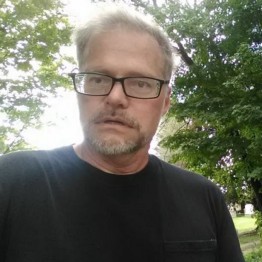
Complete Article ↪HERE↩!

Once, it was said that the eyes were the windows to the soul. Now the cellphone is. Consider Jeffrey Burrill, a man who regularly logged in to the gay dating app Grindr and whose cellphone emitted signals marking his visits to gay bars and a Las Vegas gay bathhouse. Hardly a story there, you might say.
Except Jeffrey Burrill was Monsignor Jeffrey Burrill, the secretary-general of the United States Conference of Catholic Bishops. And his July 20 resignation was forced by a newly founded Catholic online newsletter using commercially available data to trace his calls, movements, and behavior since 2018.
The outing of a top administrator of the nation’s conference of Catholic bishops was clearly a story. But what kind? A story about high-tech surveillance and invasion of privacy? About a new breach of journalistic ethics? About the Catholic Church?
Much of the national attention to this unusual episode focused on privacy issues. The basic problem is not complicated. In principle, data from mobile devices are “anonymized” by substituting a unique numerical identifier for users’ names and phone numbers. But mobile-phone location information and app usage is often recorded. A sufficiently interested party, with some additional information about residences, workplaces, and other data points, can connect the dots (or in this case the pings) to tie specific devices to specific individuals, such as Burrill.
“There’s not much to stop similar spying on politicians, celebrities and just about anyone that’s a target of another person’s curiosity—or malice,” Maggie Gile noted in Newsweek. Senator Ron Wyden, an Oregon Democrat, recalls years of warnings that data harvested from phones could be used to track their users and “reveal the most personal details of their lives.” A “vast and largely unregulated” industry assured the public that the information it collected was anonymous, he says. “As this awful episode demonstrates, those claims were bogus.”
The difficulty of safeguarding privacy from invasive technology cries out for remedies. But as a journalist and a Catholic (who has covered and written extensively about religion), I am even more interested in the other two stories, about journalistic ethics and about the Catholic Church.
I can reasonably be ranked among those labeled liberal Catholics. I am on record arguing that the Church should thoroughly rethink its teachings on sexuality, including contraception, same-sex relationships, and priestly celibacy. But I have little patience for the thankfully few dismissals of Burrill’s “indiscretions” on the grounds that “we are all sinners.” We are indeed all sinners, but we are not all secretaries-general of the United States Conference of Catholic bishops. Those of us who make solemn promises, whether of priestly celibacy or marital fidelity, should keep them. All the more so when our vows bear directly on our public roles.
If Burrill was in fact regularly violating his public commitment and leading a double life, it does not pain me that he was forced from office. What does pain me is how that came about, setting, as it does, dangerous precedents for both journalism and Catholicism.
The Pillar, the online newsletter that outed Burrill, was founded last January by J. D. Flynn and Ed Condon, two Catholic crusaders for a purer Church. Its founding statement promised to uphold “the highest standards of journalistic independence and craftsmanship.” The newsletter’s reporting on Burrill, though, has prompted questions about whether it has lived up to that mission.
The Pillar story acknowledged that the data it had obtained contained “no evidence to suggest that Burrill was in contact with minors.” But from the opening paragraph, the story missed no opportunity to mention the Church’s sex-abuse scandal, charges that Grindr and other “hookup apps” are used to facilitate sex with minors, and unrelated cases here and abroad of such criminal behavior by priests. Responding to protests that the exposé dwelled on a homophobic stereotype of gay predators, Flynn and Condon went on Twitter the day after it was published to repeat that no evidence linked Burrill’s use of gay dating apps to minors, and that they had had no intention to “insinuate” otherwise. Fair enough, if you don’t consider devoting more than 1,100 words of a 2,900-word article to that kind of linkage an insinuation.
Criticism of The Pillar’s journalism did not end with complaints about its use of innuendo. The newsletter’s resort to an ethically disturbing, even if legal, high-tech method to expose private behavior was also clouded by unanswered questions. In their lengthy exposé, Flynn and Condon went into detail about how the hookup app’s signals indicated Burrill’s systematic violation of his vow of celibacy. But they were vague about the source of this data. “The data obtained and analyzed by The Pillar,” they wrote, “was obtained from a data vendor and authenticated by an independent data consulting firm contracted by The Pillar.”
Who was the data vendor? Were the data purchased or volunteered? How were they analyzed to pinpoint a particular individual? And who funded this possibly expensive process? To critics of The Pillar’s journalism, these are key questions. Relying on anonymous sources is legitimate, and sometimes necessary. But good journalism requires giving readers some indication of the reason for anonymity and what it might suggest about the source’s perspective or motives.
Questions about the data source are underlined by another article, published at 3 a.m. on July 19—one day before The Pillar’s July 20 exposé—by the Catholic News Agency (CNA), a similarly conservative outlet where Flynn and Condon had previously worked. Written by Alejandro Bermudez, the agency’s executive director, the story said that in 2018, CNA had been approached by someone claiming “to have access to technology capable of identifying clergy and others who download popular ‘hook-up’ apps.” The person’s aim, Bermudez wrote, was to save the Church from clergy engaged in scandalous conduct. Recognizing the potential for blackmail in such data, however, the source wanted to keep them from falling “into the wrong hands.” Bermudez met with the person, who named “high-profile Catholic personalities” that the technology identified. Nonetheless, Bermudez said, he distrusted the offer and turned it down.
This is a tantalizing story, and I phoned Bermudez about it. “Chatter” from friends, he told me, about a coming revelation of online activities by major Church figures had brought to mind the 2018 offer and moved him to rush out his account. “It was important for us to say as a news organization that from a Catholic journalists’ standpoint this was a dangerous door to open.” The 2018 offer, he explained, was not only for a “whole package” but for an ongoing relationship with a steady flow of information from the source. This was hardly an ordinary offer, I noted. Was it believable, as his story claimed, that Bermudez couldn’t recall the name of the person who made it and never mentioned it to Flynn, who was CNA’s editor in chief at the time? Bermudez did not budge from his previous explanation that “crazy” accusations against Church leaders were so commonplace that they were not a matter of conversation. Avoiding any mention of The Pillar, he was simply adamant about rejecting, in 2018 and today, this way to reform the Church.
In view of the CNA story, one naturally wonders whether its unnamed source is the same person who was anonymously peddling a pre-targeted and tailored data set, indeed a working relationship, in 2018. The Pillar won’t say. (I emailed the publication to ask for comment, but received no reply.)
There is another eyebrow-raising aspect of The Pillar’s successful identification of a single individual from a data set that might have begun with billions of signals from millions of users: It’s costly. It may require a team of researchers. Not everyone agrees, but several technical experts have estimated the cost at hundreds of thousands of dollars. One data expert, Zach Edwards, the founder of an analytics firm, even said millions.
This story has opened an entirely new, scorched-earth stage of the decades-long conflict between Catholic conservatives and liberals that began after the 1962–65 Second Vatican Council, simmered for decades, and has broken into civil war since the election of Pope Francis in 2013. The issues at stake in this struggle include changes in the liturgy authorized by the Council, questions about sexual morality that the Council never considered, and the relationship between the papacy and bishops around the globe. Should the priesthood continue to be open only to celibate males? What priority should the Church give to issues of personal, especially sexual, morality compared with those of social justice?
These debates are not new. But what was once jousting among theologians, intellectuals, and papal authorities, as the laity silently aligned themselves with one side or the other, has become a battle between Pope Francis and a phalanx of high-ranking bishops. In August 2018, the retired Vatican diplomat (and onetime Vatican ambassador to the U.S.) Archbishop Carlo Viganò even demanded that Francis resign.
When Flynn and Condon, both trained as canon lawyers—specialists in Church law—started The Pillar in January, they declared that the newsletter would be “independent of any ecclesial agenda but the holiness of the Church.” Yet their take on “the holiness of the Church” implies a definite “ecclesial agenda,” on which few concerns rank higher than sexual morality, at least as I read it. To Flynn and Condon, a major threat to that holiness is tolerance of homosexuality and homosexual conduct, particularly among the clergy and bishops.
For decades, Catholic ultraconservatives have charged that the Church’s American hierarchy was being manipulated by a gay cabal. The same note has been sounded by Archbishop Viganò, who extends this charge to include Vatican circles. In a different register, it has been sounded by gay advocates, including gay priests and ex-priests, who argue that the hidden lives compelled by the Church’s strictures against same-sex relations are responsible for grave pathologies among the clergy. Even some advocates of a married (heterosexual) priesthood have echoed something similar: The requirement of celibacy has made the Catholic priesthood a refuge for many gay men who have not come to terms with their sexuality.
For The Pillar, Burrill was no one-off. It had already taken its data set to the archdiocese of Newark, headed by Cardinal Joseph Tobin, a strong supporter of Pope Francis, and to the Vatican itself. The Pillar claimed that signals from both homosexual and heterosexual hookup apps going back to 2018 could be traced to “more than 10” Newark rectories and clerical residences, including “several” with a frequency indicating use by residents. (The Newark archdiocese has 212 parishes.) As for the Vatican, The Pillar reported that over six months in 2018, at least 32 mobile devices emitted signals from dating apps, including Grindr, within areas of Vatican City not accessible to the public. By The Pillar’s standards and my own very traditional ones, all these hookup efforts in Newark and Rome were regrettable, but whether their numbers should be considered extensive or whether they came from clergy or lay employees, the newsletter did not say.
One wonders if the bishops conference, like so many corporations confronting charges of sexual impropriety, might not enlist an independent investigator to shed light on the whole episode. Who, for example, promoted and vetted Burrill for his post? How did his quite extensive double life escape notice? It is an unnoted irony that Burrill was ordained in the diocese of La Crosse, Wisconsin, when its bishop was Raymond L. Burke, today an archbishop, a leading opponent to Pope Francis, and an outspoken advocate of Church teachings on homosexuality, divorce, and abortion. Nothing in Burrill’s subsequent career steps marked him as anything but a conventional doctrinal conservative.
Questions about Burrill are only the starting point. What are the implications for Catholicism if the traditional surveillance of theological ideas and pastoral practice by Church authorities is replaced by the high-tech surveillance of moral failings by freelance journalists? The implications for journalism and personal privacy are serious. Even the person peddling the surveillance technology back in 2018 recognized its potential for blackmail. Without either strong professional censure or legal regulation, tech-savvy and scoop-hungry reporters on the brawling frontiers of online journalism are likely to make this kind of personally invasive technology part of their tool kit. A thoroughgoing inquiry and report could be a service well beyond the Church.
Defenders of The Pillar’s actions have shrugged off these concerns about privacy, journalism, and the Church. Stephen P. White, of Catholic University and the Ethics and Public Policy Center, dismissed those “ticked off” by The Pillar’s reporting—including “data-security gurus, would-be gatekeepers of the journalistic guild,” and “the usual voices on Catholic social media who cry ‘homophobia’ every time it is suggested that an unnatural vice among clerics might be a problem worth addressing.” The real problem was that “ecclesially minded journalists like Flynn and Condon” were being treated as “pariahs” for exposing “inconvenient truths about clerical sins.” In the defenders’ confidence that no ominous red lines are being crossed here, they seem to be forgetting one fundamental component of the Catholic teaching to which The Pillar pledged itself at its founding: Original Sin.
Complete Article ↪HERE↩!
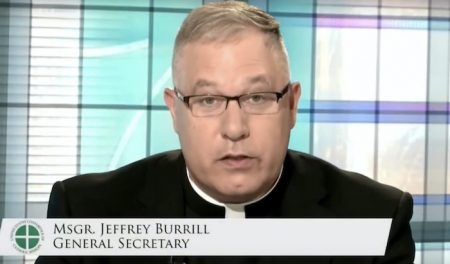
Last month, the United States Conference of Catholic Bishops (USCCB) approved a measure that could prohibit President Biden, a devout Catholic, from receiving communion. Conservative bishops do not wish Biden to receive communion because of his support for abortion rights.
Monsignor Jeffrey Burrill, general secretary of the USCCB, was a strong supporter of the measure, but he has resigned due to allegations of “serial sexual misconduct,” as reported in The PIllar, a Catholic publication. Burrill was allegedly using Grindr for sex hookups, which goes against Catholic priests’ vow of celibacy.
From The Pillar:
Use of location-based hookup apps is inconsistent with clerical obligations to continence and chastity, according to Fr. Thomas Berg, a professor of moral theology at St. Joseph’s Seminary in Yonkers, New York.
Berg told The Pillar that “according to canon law and the Church’s tradition, clerics are obliged to observe ‘perfect and perpetual continence,’ as a reflection of what should be our lived pursuit of our spousal relationship with the Church and with Christ.”
Calling it “obviously a scandal” that a cleric would use location-based hookup apps, Berg said there is “a real disconnect between the appearance of a man who presumably is earnestly striving to live the life of chastity, when it becomes glaringly evident that he is dramatically failing at that because he’s gone to hookup apps to look actively for sexual partners — that itself is an enormous scandal.”
As Upworthy points out, you’d think Monsignor Burrill would have more empathy toward President Biden:
Burrill appears to be an even bigger hypocrite because the USCCB has opposed LGBTQ equality, same-sex adoption, and the development of an LGBTQ suicide hotline. It has also promoted anti-trans legislation.
It always seems to be that the religious folks who judge the harshest always wind up having something to hide. It’s a shame that Catholics such as Burrill are forced by doctrine to live their lives in the shadows. But shouldn’t that make them more compassionate towards fellow sinners instead of the first to judge?
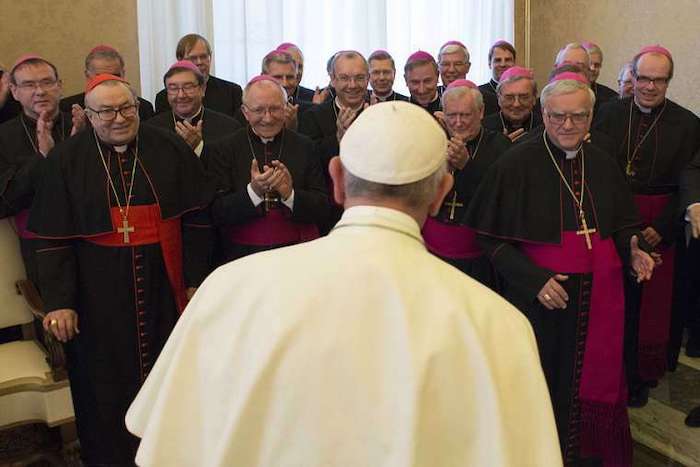
By Claire Giangravé
At last month’s Pride parade in Rome, members of the city’s LGBTQ community waved rainbow flags, strewed glitter and generally exuded love to fellow marchers and those along the route. When they occasionally showed flashes of ire, their mockery and ridicule were aimed at some of Rome’s most familiar figures: Pope Francis and the Vatican hierarchy.
Some shouted at the churches they passed; others held sparkly signs with double-entendres aimed at the pontiff. Still others strutted their stuff dressed as Francis himself.
What angered Italian LGBTQ citizens was what they considered undue interference by the Vatican in its attempt to stall a controversial bill being debated in the Italian Senate that would criminalize homophobia. Named for its author, politician and activist Alessandro Zan, the bill would also institute a day aimed at raising awareness of sexuality and gender issues in schools.
Italian bishops have twice voiced their concerns about the Zan bill, claiming it would violate the religious freedom of Catholic schools, hospitals and other institutions. When that admonition fell on deaf ears, the Italian bishops’ conference sent a diplomatic note to the Italian government on June 22. The Zan bill, the bishops argued, violated the accords signed in 1929 between Italy and Vatican City, known as the Lateran Treaty, that set expectations for mutual noninterference.
In the middle of this heated debate, Francis sent a letter to the American Jesuit priest James Martin, about Martin’s efforts to promote inclusivity and to welcome LGBTQ individuals in the church.
“Our Heavenly Father comes close with love to each one of his children, each and everyone,” Francis wrote in the letter, praising Martin’s work.
Ever since Francis answered a question about a gay priest in 2013 with his own now famous question, “Who am I to judge?,” many Catholics have hailed the pontiff as a beacon of hope for LGBTQ inclusivity.
But while Francis has often shown in his words and personal acts of charity that he is close to LGBTQ individuals, the Vatican as an institution has done little to recast its hard doctrinal line, which views homosexuality as sinful and as “intrinsically disordered.”
“I can understand that it’s very confusing for people,” said Juan Carlos Cruz, a clerical abuse survivor and member of the LGBTQ community who frequently meets with Francis at the Vatican.
Despite the Vatican’s recent interference on the Zan bill, “that’s not who Pope Francis is,” Cruz said, adding that in private conversations the pontiff makes it clear that not only did God make the activist gay, but loves him the way he is.
Cruz made it clear that while he enjoys a personal relationship with the pope, and while Francis appointed him to the Pontifical Commission for the Protection of Minors in 2020, he is not a papal spokesperson.
Jamie Manson, president of Catholics for Choice and a longtime activist for LGBTQ rights in the Catholic Church, believes that Francis “wants to be compassionate and merciful to marginalized people — he sees us as marginalized people — but he doesn’t want to change the teachings that will free us from marginalization and get us justice.”
Catholic LGBTQ organizations are divided, Manson explained, between those who believe that “appealing to mercy and pulling at heartstrings” will lead to change in the Vatican and those who “have run out of patience.”
Occasionally the pontiff’s statements on homosexuality seem to contradict themselves. He has personally supported LGBTQ individuals in Italy and in Argentina — and last September, speaking to Italian parents of LGBTQ children, Francis said that “God loves their children as they are” and so does the Catholic Church. But he has also criticized gender theory, comparing it to nuclear weapons and calling it a form of ideological colonization.
The dynamic can be attributed to a “hate the sin, not the sinner” approach, but according to Cruz, it also suggests that there is not a little opposition to Francis’ support for LGBTQ Catholics among Vatican officials.
“I’ve never seen in my life a more political and LGBTQ-obsessed Curia,” he said. “It is sad to see how much Pope Francis wants to support and open his arms to the LGBTQ community and how much they put land mines in his path to be able to do it,” he added.
Concerning the CDF’s ban on the blessing of same-sex couples, which occurred shortly after Francis returned from his historic trip to Iraq, Cruz said he believes that “in some way (the pope) is going to try to repair the harm that document did.”
The CDF document, approved by Francis, seemed to be an attempt to rein in the discussions taking place in Germany known as the Synodal Path — a series of conferences involving local bishops and laity that has taken a progressive line on questions regarding sexuality and power structures in the Catholic Church. But LGBTQ Catholics in other countries regarded it as a gratuitous slap, and despite the ban from the Vatican, some German clergy have continued to bless same-sex couples.
Manson praised the pope for opening the conversation on LGBTQ issues in the church, which she believes has led to “meaningful change,” but she added that the time for talk is over. She called for the pope to meet with members of the LGBTQ community at the Vatican and publicly acknowledge his private statements on LGBTQ issues.
Cruz said that he known he’s “lucky” to be able to speak to the pope directly on these topics, praising Francis’ efforts to evolve the Vatican’s understanding of LGBTQ individuals, while adding that “we cannot change church teaching in a minute.”
He also longs for the pope to speak openly on these topics, he said, and for him not to “let others define it for him.”
Complete Article ↪HERE↩!
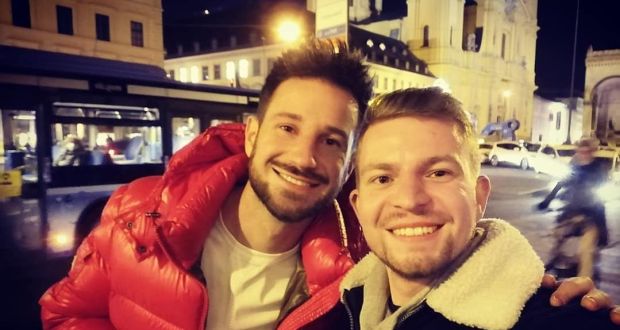
By Derek Scally
There was no fairy-tale ending for Henry Frömmichen after his chance encounter with Prince Charming.
Last autumn the 21-year-old German seminarian was hurrying across Munich’s Odeonsplatz when he spotted Alexander Schäfer, the lead in a popular gay reality show.
“Everyone in the seminary watched it, just not me, but I knew him from Instagram,” said Frömmichen. “I introduced myself as a seminarian and it was a great conversation.”
The problems began when he posted a selfie with Prince Charming to his Instagram account – with a church in the background.
Unwittingly, he had exposed the gap between Catholic teaching, and discretionary practice, over admission of homosexual men to the priesthood. He paid a heavy price: expulsion from the seminary last November.
Frömmichen insists he was ready to lead a celibate life as required of all Catholic priests. During seminary admission interviews he remembers being asked in a general way about his sexuality and whether he had any relationships.
“I said I had given up a relationship for this step because it was a greater source of excitement for me to enter the priesthood,” he told German radio. “When I tell people this they think, ‘he’s not quite the full shilling’.”
Catholic teaching states that homosexuals “must be accepted with respect, compassion, and sensitivity” but that homosexual acts are “intrinsically disordered”.
The additional hurdle Frömmichen faced is a rule introduced by Pope Benedict XVI that men with “deep-seated homosexual tendencies” or who support a “gay culture” may not become priests. The document from November 2005, the German pontiff’s first priority, says that only men who have “overcome” a homosexuality that was “transitory” and who have remained celibate for three years before joining the seminary are eligible for the priesthood.
Munich seminary director Wolfgang Lehners says he sees no reason why men with healthy relationships to men and women should not become priests.
“But when the rainbow is in the background of everything he does then it will be very difficult for someone to represent the Catholic church as a priest,” said Fr Lehners to Deutschlandfunk radio.
Six months after he was thrown out, Frömmichen went public about his shattered dream after the Holy See’s insistence in March that the church cannot bless gay couples. “There’s such a dishonesty and double standard,” he said. “As long as it’s not discussed, it’s fine . . . that’s what was insinuated to me.”
Complete Article ↪HERE↩!
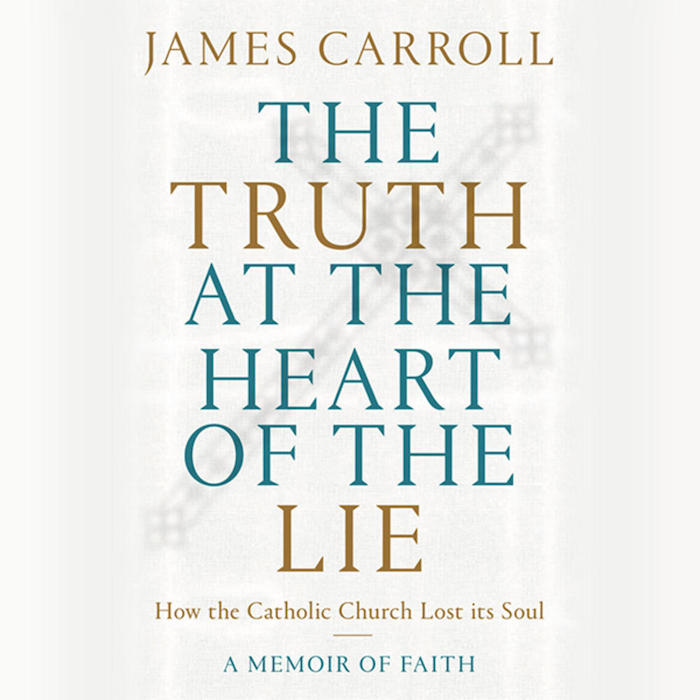
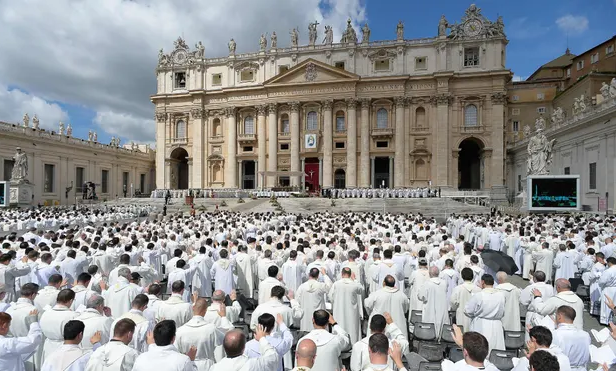
More than 230 professors of Catholic theology in Germany and other countries where German is spoken have signed a statement protesting the Vatican’s recent pronouncement that priests cannot bless same-sex unions, adding to dissent over the document.
The statement issued Monday declared that last week’s text “is marked by a paternalistic air of superiority and discriminates against homosexual people and their life plans.”
“We distance ourselves firmly from this position,” it added. “We believe that the life and love of same-sex couples are not worth less before God than the life and love of any other couple.”
The document released a week ago by the Vatican’s orthodoxy office, the Congregation for the Doctrine of the Faith, said Catholic clergy cannot bless same-sex unions because God “cannot bless sin.”
The congregation’s note distinguished between blessing same-sex unions and the Catholic Church’s welcoming and blessing of gay people, which it upheld. The document argued that such unions are not part of God’s plan and that any sacramental recognition of them could be confused with marriage.
It pleased conservatives and disheartened advocates for LGBT Catholics. The German church has been at the forefront of opening discussion on hot-button issues such the church’s teaching on homosexuality.
The professors’ statement, which was drawn up by a working group at the University of Muenster in Germany, said the Vatican note lacked “theological depth” and “argumentative stringency.”
It included signatures from professors in Germany, Austria, Switzerland and the Netherlands.
Complete Article ↪HERE↩!
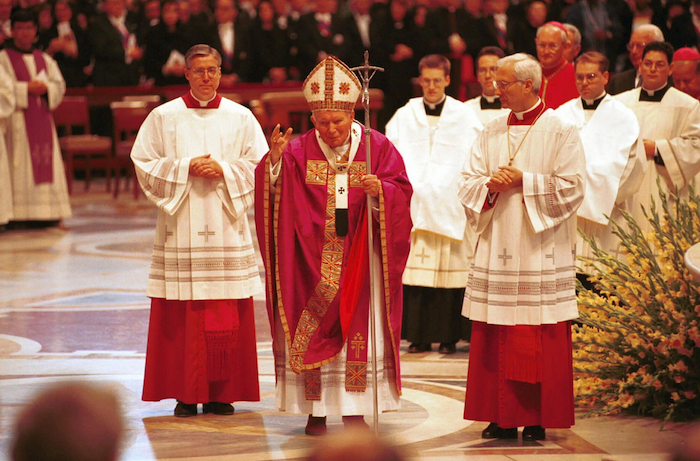
At the funeral of Pope John Paul II at St. Peter’s Square, banners rose from the sea of mourners reading “Santo Subito,” or “Saint at Once.” He was a giant of the church in the 20th century, spanning the globe, inspiring generations of believers with his youthful magnetism, then aged infirmity, and, as the Polish pope, he helped bring down Communism over his more than 26-year reign.
Days after his death in 2005, cardinals eager to uphold his conservative policies had already begun discussing putting him on a fast track to sainthood while devotees in Rome and beyond clamored for his immediate canonization, drowning out notes of caution from survivors of sexual abuse and historians that John Paul had persistently turned a blind eye to the crimes in his church.
Now, after more than a decade of doubts, his reputation has fallen under its darkest cloud yet, after the very Vatican that rushed to canonize him released an extraordinary report this week that laid at the saint’s feet the blame for the advancement of the disgraced former prelate Theodore E. McCarrick.
The investigation, commissioned by Pope Francis, who canonized John Paul in 2014, revealed how John Paul chose not to believe longstanding accusations of sexual abuse against Mr. McCarrick, including pedophilia, allowing him to climb the hierarchy’s ladder.
The findings detailed decades of bureaucratic obfuscation and lack of accountability by a host of top prelates and threatened to sully the white robes of three popes. But most of all, critics say, it provides searing proof that the church moved with reckless speed to canonize John Paul and now it is caught in its own wreckage.
“He was canonized too fast,” said Kathleen Cummings, author of “A Saint of Our Own” and the head of a center on U.S. Catholicism at the University of Notre Dame. She said that given the “really damning evidence,” in the report, had the church waited at least five years, and not mere days, to begin the canonization process “it would probably not begin for John Paul II because of his complicity in the clergy sex abuse scandal.”
A reversal of the canonization, which historians struggle to recall ever happening, is implausible. Some historians say the McCarrick report is more likely to put back some brakes on a process that John Paul II himself sped up. But the report may complicate the canonization chances of others at the top of the church hierarchy during the late 20th century and early 21st century, when the scourge of sex abuse exploded in the church.
The Vatican report shows that Pope Benedict XVI told Mr. McCarrick to keep a low profile when more allegations of abuse emerged in 2005. Pope Francis, despite hearing rumors of the abuse from his top lieutenants, trusted that his predecessors had properly vetted the case and left it alone, the report found.
Francis has acknowledged his own failures in believing bishops over victims. He removed Mr. McCarrick from the priesthood and has in recent years instituted new church policies to increase accountability.
Many church experts consider those new rules corrections to the abuses and almost willful ignorance of church leaders that occurred under John Paul II.
John Paul II’s defenders say the report only demonstrated that Mr. McCarrick deceived the pope, as he did many others over his half-century rise to the highest ranks of the Catholic Church, and that it has no bearing on the heroic Christian virtue that made the pontiff a saint.
John Paul had been “cynically deceived” by Mr. McCarrick and other American bishops, Stanislaw Gadecki, the head of the Polish bishops conference said in a statement.
“Saints make errors of judgment, this was clearly an error of judgment,” said George Weigel, a biographer of Pope John Paul II and an official witness during his beatification process. “McCarrick was a pathological liar. And pathological liars fool people including saints.”
Mr. Weigel said that if perfection were a prerequisite for sainthood, St. Peter himself would not have made the cut. Indeed, infallibility, which is sometimes attributed to popes, is not a necessary saintly attribute, and history is full of saints who were not exactly saints during their lifetimes.
There has been a satanic priest, prostitutes, thieves and much else on the road to redemption and sainthood. In 1969, Pope Paul VI removed 93 saints from the church’s universal liturgical calendar, but mostly because they might not have existed, such as St. Christopher, who carried on his shoulders an infant who with each step grew heavier with the weight of the world.
But much is known about John Paul II, and some critics are arguing that it is enough cause not to celebrate him.
Citing John Paul’s “calamitous, callous decision-making,” which it said put children around the world at risk, an editorial Friday in the National Catholic Reporter urged American bishops meeting next week for their annual conference to “discuss requesting that the Vatican formally suppress John Paul’s cult,” or cease celebrating him. “Abuse victims deserve no less.”
That is a tremendous irony for a pope who turned the church into an efficient canonization factory. John Paul knocked down the criteria for beatification from two miracles to one, and did the same for canonization. In 1983, he reduced the amount of time required between a person’s death and the start of their canonization process to five years from 50.
He produced more than 480 saints, and put enough into the pipeline that Benedict XVI was able to canonize scores more. Pope Francis has followed suit, but has chosen to canonize people closer to his more pastoral, and less doctrinaire, vision of the church, such as Pope Paul VI and the martyred Salvadoran Archbishop Óscar Romero.
All three of the popes embraced the canonization process as a tool to fortify the faithful with the notion that saints are still among us, but also as mission statements for who merits emulation. Given the ideological divisions in the church, that approach puts a premium on speed.
“A process normally begins after five years of the death of the Servant of God and not later than 30 years after his death,” the Rev. Pascual Cebollada, the postulator, or person who presents a case for canonization, for the Jesuit order, explained. “For the last condition there are, of course, many exceptions that must be justified. For the first,” he added, “there have been less exceptions.”
John Paul was one of them. Benedict XVI waived the five-year requirement, allowing his canonization case to begin only days after his death. Even before the McCarrick report’s release on Tuesday, there was a growing sense that might have been a mistake.
In May, reporters asked Msgr. Slawomir Oder, the promoter of the cause for John Paul’s sainthood, whether it would have been wiser to hold off on the canonization. Already by that time, a cloud had grown over John Paul’s relationship with Mr. McCarrick and his close ties to the Rev. Marcial Maciel Degollado, the Mexican founder of the wealthy and powerful religious order Legionaries of Christ, who was later found to have fathered several children and been a serial abuser.
“All questions were faced, even the ones you are talking about” concerning abuse, Monsignor Oder said. He added that “John Paul II did not cover up any pedophile.”
But Monsignor Oder, who did not return a request for comment after the report’s publication, also said at the time that the Vatican did not grant direct access to the archives to those investigating the case for John Paul’s canonization, and that the Secretariat of State researched their questions and provided answers.
Archbishop Carlo Maria Viganò, a former official in the Secretariat of State who became the Vatican’s ambassador to the United States, in part prompted the report by publishing a remarkable letter in 2018 that accused Pope Francis of having covered up Mr. McCarrick’s abuse.
To shield John Paul II, who was actually in power at the time of Mr. McCarrick’s promotions, Archbishop Viganò argued that the ailing pontiff was too sick with Parkinson’s in 2000 to be held accountable.
But the Vatican investigation, which Archbishop Viganò said did not interview him, says that John Paul was of sound mind when he personally made the decision to reject the accusations and appoint Mr. McCarrick.
“The record unequivocally shows that Pope John Paul II made the decision personally,” the report says, and quotes the testimony of the former prefect of the papal household, James Harvey, saying John Paul was “fully capable to make all of his own decisions in 2000.”
The more frequent defense of John Paul, expressed also in the report, is that his experience facing Communism in Poland led him to believe that false accusations against priests and bishops were a political weapon against the faith.
But the reports give a rare glimpse at other, less noble, factors that led the pope to believe Mr. McCarrick, namely that the Vatican operated like an old boys network where bishops always got the benefit of the doubt.
John Paul first met Mr. McCarrick in 1976. Mr. McCarrick, the report says, “was on a fishing trip in the Bahamas with teenagers from some of the Catholic families” when a telegram told him to come back immediately to help translate for Pope John Paul II, then known as Karol Jozef Wojtyla, a rising star in the church. Mr. McCarrick joked that Cardinal Wojtyła had ruined his vacation and they struck up a friendship.
A quarter of a century later, Mr. McCarrick urged John Paul in a letter not to believe the accusations against him.
Pope John Paul II became “convinced of the truth” of McCarrick’s denial, the report notes, adding that Stanislaw Dziwisz, now a Cardinal, recalled that Pope John Paul II also believed it would be “useful to nominate McCarrick to Washington because he has a good relationship with the White House.”
Those events, as well as others in the report, have led some historians to suggest that the church redirect its canonization energies away from the top of the hierarchy.
“You are pope,” Professor Cummings said. “That should be good enough.”
Complete Article ↪HERE↩!
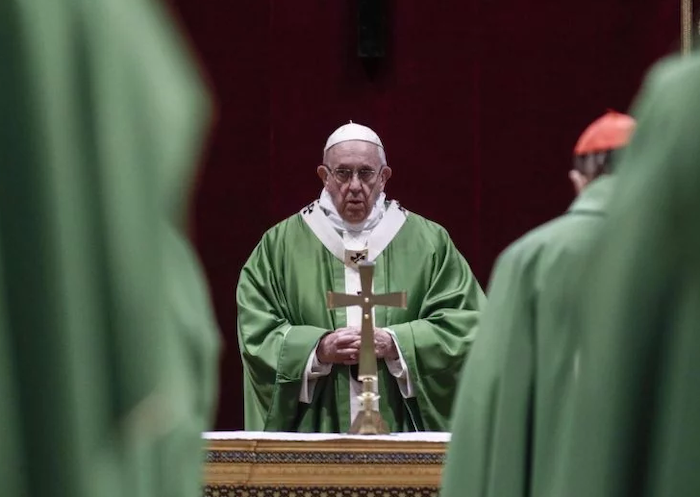
By Mary Hunt
Roma locuta; causa finita est, attributed to Augustine, means: “Rome has spoken, the matter is closed.” So it is. Sordid details emerging of Australian Cardinal George Pell’s conviction on “multiple historical child sex offenses” are no great shock. They only confirm the general consensus that the recent Roman summit was a dismal failure of nerve and justice at a time when only nerve and justice will suffice.
Survivors of sexual abuse, women religious, LBGTIQ advocates, and some journalists made impressive showings during the recent “Protection of Minors in the Church” meetings in Rome. Pope Francis, cardinals and bishops, not so much. The Vatican had lowered expectations going into the meeting once it became clear that Catholic people around the world demand action not just words. From all that I saw and read—talks and press conferences were live streamed; press coverage was extensive—the clerics came in well below even their own low bar.
As I surmised beforehand, the meeting was “held at the wrong time with the wrong people about the wrong issues.”
Just imagine if the meeting had been held in September 2018, right after the Pennsylvania Grand Jury report was issued with its shockingly large number of victims and offenders. That would have also been right after reports came out that Cardinal Theodore McCarrick had abused countless seminarians and priests. The Vatican crowd could have saved themselves a lot of grief.
Think of what would not have been on the table. Many terrible revelations have emerged since September:
In fact, all of that data was part of the backdrop of the meeting, but no one peeped about most of it. Maybe next time the clerics will learn to act faster for their own good.
Pope Francis gathered 190 heads of bishops’ conferences as well as ten women religious who lead their orders and their equivalent in men’s congregations for the summit. But the real action was in the streets and surrounding buildings, where scores of sex abuse survivors and their supporters protested, told their stories, and gave interviews.
The more the clerics droned on in endless platitudes and careful parsing in lieu of implementing policy, the more the survivors garnered credibility and sympathy. A skilled facilitator would have invited the survivors into the hall, paired them each with a bishop, and invited them together to lay out constructive next steps for the church. Alas, no such forward-looking person was in a position to do so, least of all the much-touted and deeply disappointing pontiff.
Instead, the official meeting featured videos of survivors at yet one more remove from the bishops, many of whom had never listened to survivors in their own dioceses. It’s no wonder. These stories are hard to hear. One woman in a video told of being forced as an underage teen into sex with a priest; he paid for her three abortions. Some bishops expressed genuine shock, leading observers to wonder where they have been for the last two decades.
Still others continued to externalize the problem as a Western issue, suggesting, for example, that problems like child soldiers demand equal time. No doubt, good brothers, but the stated focus of the meeting was on the protection of minors, with the implied tagline “from priest/bishop abusers.” There are many actionable forms of abuse of children, but this time the focus was on that perpetrated by and covered up by clerics. The Vatican was not trying to solve the world’s problems, but to look at its own.
By many measures it failed miserably. The gathering was too homogenous to be useful. It was framed in the same old top-down way that’s at the heart of the problem. Lay people, both women and men, experts in the law, psychology, theology, and the like were excluded. Clerics met in small groups to talk with other clerics. What could be more wrong with this picture?
Pope Francis in his final statement captured the egregious miss that was this meeting. He started off generally: “Our work has made us realize once again that the gravity of the scourge of the sexual abuse of minors is, and historically has been, a widespread phenomenon in all cultures and societies.” Then he went on to contextualize clerical abuse by talking about the high incidence of abuse at home. He’s right, of course, but the difference is that families don’t have as their reason for being the well-being of the world’s people. That is the Church’s (now empty) claim.
He painted a broader picture of pornography, sex trafficking, and other precipitating forces that make up “the mystery of evil, which strikes most violently against the most vulnerable.” There is no mystery here. His priests and bishops abused minors and some covered it up. What’s so mysterious about that? A large number of minors have been sexually abused by a large number of clerics. Period. Full stop. It’s simply the beginning of a hideous story that includes the abuse of seminarians, nuns and other women, children of priests, and more, all of whom merit summits of their own.
Francis’ discussion of power fell flat. He claimed that the sexual abuse of minors is an abuse of power. He completely passed over the structures of vastly unequal power between clergy and laity that are the bedrock of this power differential, a causative factor in church-related abuse. Without changing those structures the chances of eradicating sexual abuse of minors by clergy are nil.
Francis concluded with nothing new, concrete, or effective, using vacuous terms like “impeccable seriousness” and “genuine purification,” highly spiritualized notions that might ground new policies. I do not think so. And I know that few are going to wait around to find out.
Survivors and their supporters left empty handed while bishops toddled off to their dioceses without clear direction. On the one hand, one can applaud Francis for not imposing new laws by fiat, for inviting people to a “personal and communal conversion.” But “zero tolerance” is hardly a new idea or something around which consensus has to be built. It does not mean someone must leave the church as the McCarrick case proved, only that the person be dealt with by civil authorities and leave ministry where the possibility of abusing power remains. Is that too much to ask in the face of mounting evidence of criminal behavior and cover-ups?
On the other hand, Francis’ approach might mean that church teachings and polity will be handled locally as abuse cases are. Catholics can rejoice that such moral sticky wickets as abortion and homosexuality, and such disputed matters of ecclesiology as the ordination of women and married men to the diaconate and presbyterate, will soon be announced as local options as well. I doubt sincerely that this is in the cards, but it follows logically. Logic was at a premium in Rome during the summit.
This dilemma, this selective use of papal power, points to the fundamental problem at hand. It’s the need for new ecclesial structures rooted in a realistic theology that would mitigate power inequities and begin to reshape the global Catholic Church into safer, more participatory communities with the full participation of women and lay men in every facet of church life.
To that end, the undisputed highlights of the meeting were the three presentations by women. Some of the clerics expressed surprise that Canon Lawyer Linda Ghisoni, Nigerian Sister of the Holy Child Jesus, Veronica Openibo, and longtime Mexican journalist, Valentina Alazraki, had such powerful and well-grounded analyses, and that they minced no words in their articulation. Apparently the men have been asleep for the last four decades when Catholic women have developed such competencies with no help from the institutional church.
Dr. Ghisoni challenged the overuse of official forms of secrecy in the Vatican, the so-called “pontifical secrets,” claiming that much of what had been hidden for the sake of protecting good names and the institution was relevant for public discussion. She knows that Canon Law can and must change. Pope Francis’ bizarre comment about feminism being “machismo in a skirt” following her talk suggests that she might have struck a little close to home.
Sister Openibo asked the clerics why they had persisted in silence for so long: “Why have other issues around sexuality not been addressed sufficiently, e.g. misuse of power, money, clericalism, gender discrimination, the role of women and the laity in general? Is it that the hierarchical structures and long protocols that negatively affected swift actions focused more on media reactions?” She concluded with the need to “be proactive not reactive in combating the challenges facing the world of the young and the vulnerable, and look fearlessly into other issues of abuse in the church and society,” marching orders for those who want to solve this problem.
Valentina Alazraki, a veteran Vatican journalist who has worked during five pontificates over four decades taking 150 papal trips, was equally frank. She left these words ringing in the ears of the assembled: “… we journalists are neither those who abuse nor those who cover up. Our mission is to assert and defend a right, which is a right to information based on truth in order to obtain justice. We journalists know that abuse is not limited to the Catholic Church, but you must understand that we have to be more rigorous with you than with others, by virtue of your moral role.”
She recommended that the clerics turn over a new leaf with the new onslaught of information about the abuse of women in the church. This time, she counseled the institution to “play offense and not defense, as has happened in the case of the abuse of minors. It could be a great opportunity for the Church to take the initiative and be on the forefront of denouncing these abuses, which are not only sexual but also abuses of power.” Nothing that emerged from Pope Francis’ finale, nor from the final press conference that included Vatican spokespeople, indicated that this would happen. Nonetheless, the women speakers pointed the way forward.
No one expected a miracle or a magic solution to the deeply entrenched problem of sexual abuse of minors at this meeting. Given that the abuse of women, including nuns, has not been addressed at all, and that the cases and lists of perpetrators continue to roll out (along with the conviction of George Pell, Pope Francis’ handpicked leader of the Vatican’s finances), there’s little reason to expect anything at all from Rome.
There’s solace in the strength of survivors, the savvy of these women speakers, and the solidarity of people around the world. When asked for bread, the Roman Catholic Church can no longer get away with giving a stone (Matthew 7:9). Roma finita est.
Complete Article ↪HERE↩!